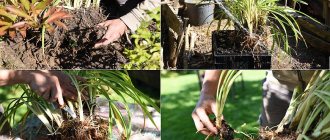Peony growth periods
The growth of the peony bark system occurs in spring and autumn. In the last days of January - early February, the tubers of this plant emerge from the state of winter dormancy. Their growth begins at +5°C.
Simultaneously with the beginning of root growth, shoots develop. On average, spring growth of peonies continues until the end of their flowering.
During the spring growth phase, suction roots actively help the plant. With their assistance, peony accumulates nutrients. There will be enough of them to ensure flowering this season, and to lay growth and flower buds for next year.
When flowering ends, root growth also stops. With the arrival of heat, the plant remains in the summer dormant period.
Resumption of growth of the peony root system occurs when the soil cools to +10°C - +15°C. Usually this time falls at the end of August - beginning of September (depending on the climate of the area). This period of peony growth is called autumn. Based on this, the best time for dividing and planting peony roots is considered to be the end of August - the beginning of the third ten days of September. At this time, new buds have already formed, and the roots begin the second stage of growth. Thus, they enable the plant to prepare for winter by supplying nutrients to the root system.
How to preserve peonies until spring: we protect old and new ones before planting
Contents 1 Why a peony needs protection in winter 2 Preparing flowers for winter, depending on the planting location 3 Ways to protect peonies for the winter 3.1 Basic rules for pruning 3.1.1 Video: trimming and covering a peony for the winter 3.2 What to cover for the winter 3.2.1 Video: covering tree varieties 4 Digging up rhizomes: how to preserve them until spring 4.1 […]
Why does a peony need protection in winter?
In winter, the peony bush needs protection. He is very vulnerable, afraid of frost. The fact is that the renewal buds, from which a stem with a fragrant lush flower subsequently grows, are laid on the rhizome of the peony - the underground, wintering part of the plant.
In a properly planted plant, the growth buds are buried 3–5 cm, which means that in winter frosts, without additional shelter, they can freeze, and the peony, at best, will not bloom, and at worst, it will die.
Preparing flowers for winter depending on the planting location
Peonies growing in the same area, but in different places, can tolerate winter cold differently and will require different preparations for winter. For example, in the southern regions, a peony bush may need natural shelter from snow cover. Plants planted next to fruit bushes and trees will be well protected. They will create natural and comfortable protection for the peony.
A peony planted next to a tree or shrub will be protected from drafts and will more easily withstand winter frosts
Peonies growing at higher elevations definitely need additional protection. Snow in such areas does not stay long and is blown away by strong winds. Bushes growing in lowlands also need shelter for the winter. Stagnation of humidity and cold air leads to freezing of the plant.
Ways to protect peonies for the winter
Peonies are low-winter-hardy plants, so the success of their wintering depends on how the bush is prepared and protected. In the fall, it is necessary to prune the peonies, and then cover the bushes for the winter or dig them up.
Methods for storing peonies
Before storing peony roots before planting (purchased or dug), they are carefully inspected. Areas with signs of rotting are removed with a sharp knife until healthy tissue is removed. After this, the damaged areas are treated with brilliant green, fungicide or other antiseptic.
Peonies should be stored at a temperature of +2°C - +4°C. Such conditions are possible in the cellar or vegetable compartment of the refrigerator. If the roots are in boxes, they must be sprinkled with sawdust.
Another way to store peonies is in a plastic bag with holes for ventilation. The rhizomes are pre-wrapped with moss (sphagnum) and their condition is constantly monitored. It is important to prevent them from drying out.
When the buds swell and suction roots appear, the division is planted in a container with moist soil. It is possible to store peonies in the ground before planting them in open ground in a cool room.
When the flowers begin to actively grow, they are transferred outside and buried in the ground. You can also leave them in your apartment in a flower pot until autumn. This way the plant’s growing season will pass, and it will be able to normally transfer the subsequent planting to the flowerbed.
It is also possible to preserve peony rhizomes in a container with sand. The sand is pre-washed. The planting material should be located in a place with a temperature of up to +10°C, and the sand will need to be periodically moistened.
With this storage method, the buds begin to wake up in March, and shoots will begin to grow in early May.
The dug out roots of tree peonies and their hybrid species should be stored under the same conditions as the roots of herbaceous peonies.
How and where to store peony roots separated in autumn
Under normal growing conditions and compliance with all agrotechnical work, peonies grow in one place for a long time and they rarely require root division, digging and replanting. If you divided the peonies in the fall, but for some reason did not (could not) plant the roots again, then the question arises of how and where to store them in the winter until next spring. We will answer the question and tell you what conditions are necessary for this.
How and where to store peony roots separated in autumn
We remind you that before digging up peonies and storing them, it is necessary to trim the leaves at least 10-15 cm from the ground. Read more in the article Peonies - preparing peonies for winter
I tried storing peonies in sphagnum moss in plastic bags with holes. Not bad! If you have nowhere to store it at home, then do it on the balcony, provided that it is glazed and maintained at a temperature of up to +4°C.
Another option, if there are only a few peonies, you can plant each root in a small container and place it under the bathtub or in a cool corner of your apartment. In the spring, you will need to transfer them along with the soil into larger containers, for example, into flowerpots or old buckets. And at the end of summer, all that remains is to assign them to a permanent place in the garden by replanting them with a lump of earth from the flowerpot to the flower garden. Thus, peonies will begin their development in the fall, and the root system will remain intact.
Outside the site, a large number of peony rhizomes are prepared, as stated in the article Peonies: if you did not have time to plant peonies in the fall, they are placed in wooden boxes or cardboard boxes, sprinkled with sawdust, vermiculite, sand, etc.
If you have to transport peonies to a completely new place, but you have not dug up the roots, then the best option is to store them there in the ground on the site, and dig them up and transport them in the spring.
Attention!
Spring planting, although permitted, is highly undesirable: you need to be very careful and cautious, as
peony sprouts are very tender and brittle;
peony buds wake up early, so wait for a period when the soil has thawed, but the plant itself has not yet begun to grow;
additional fertilizing, watering, hilling, and shelter will be needed, since spring frosts can destroy a young tree;
Plants take longer to grow their root system, which means they will bloom later.
The storage locations for peonies can be different: a house, a refrigerator (if the quantity is small), a garage, a basement, a glazed and heated veranda in the country, etc. You just need to follow three rules:
maintain temperature from +2° to +4С°;
do not allow sunlight to fall on the divisions;
Make sure that the substrate in which the peonies are stored is moist, but not wet, to avoid drying out the roots.
When storing peonies outside the site in winter, do not forget to check them and moisten them, preventing them from drying out. But if the temperature or humidity, on the contrary, is high, then the peonies will begin to grow ahead of time (in February-March) and they will have to be planted in pots (boxes) at home or taken to the dacha and planted under cover. And this is risky, since young shoots may not withstand cold night temperatures, and during the day they may get burned in the bright spring sun.
The main thing is to understand that in any case, peonies dug out of the ground and stored in boxes are not their natural development: after all, this does not happen in nature! And this means your plants will experience stress throughout the entire period of being in other conditions. And during spring planting, unfamiliar land awaits them, which means new challenges. Be prepared that peonies in this case will develop slowly at first, and flowering will be delayed for several more years.
Author of the article: Love
When copying text, please indicate the address of our website.
Rules for cutting peonies
Flowers should be cut in cool weather, early in the morning. It is better to choose half-closed buds. They will last for a long time.
Flowers intended for transport should not be cut in the rain. Drops of rain falling on the buds cause them to instantly darken. It is best to cut the flowers before sunrise, after which they are wrapped in paper and placed on the refrigerator shelf.
It is possible to store cut peonies in the cold for up to 20 days.
Flowers should be cut using well-sharpened garden tools (secateurs, special scissors). In this case, the cuts on the stems are made oblique.
Flowers are not cut off at the very roots, and it is advisable to leave a few leaves on the stems.
Storing peonies in a vase will last for a long time if you choose the right flowers for cutting. The bud should not be too hard to the touch when lightly squeezed. At the same time, the flower does not yet have a bright color.
Preparing peonies for winter: pruning and covering
One of the most common garden flowers are peonies. They are very popular among gardeners.
The plant is considered unpretentious, but there are still some nuances in its cultivation that all breeders of this beautiful shrub must know.
Particular attention should be paid to the issue of covering peonies for the winter, because the bright bloom of these luxurious flowers depends on this.
Types of shrubs
Preparatory measures for the winter period are the key to active flowering of the plant. But in order for it to please the owner in the fall, it is necessary to make some efforts to prepare the bushes for the cold. There is no need to dig them up for the winter, but other important agrotechnical measures must be carried out.
All perennial peonies are divided into:
- herbaceous - ordinary garden peonies, which so often become favorites in garden plots;
- tree-like - they are distinguished by their impressive bush size and stems, which become woody over time.
Both types are subject to annual autumn preparation. In addition, the plant is not winter-hardy, so it needs shelter for the winter.
Features of the preparation of herbaceous species
Peonies need to be thoroughly prepared for cold weather. Experienced gardeners recommend simply adhering to certain care measures. What you need to do:
- feeding shrubs during the growing season;
- replanting shrubs if necessary;
- autumn pruning;
- mandatory mulching;
- insulation of bushes for the winter.
This work must be completed in the fall. The only thing you can skip is the transfer. If there is no such need, it is not necessary to do this, however, successful wintering also depends on the place where the bush grows.
A perennial planted between fruit or ornamental bushes will withstand winter better than a peony growing in an open place. The second option will need to provide additional cover. You should decide what is easier - replanting or covering, and act on this basis.
Description of bougainvillea and cultivation at home
Plant pruning and timing
Pruning peonies is also important. Inexperienced gardeners often do not understand why it is carried out and skip this procedure, thereby making a grave mistake.
The above-ground part of the bush dries out after the next development cycle and becomes an excellent place for pests to overwinter, where they will lay larvae and eggs. In addition, pathogenic microbes may be hiding on dried leaves. Therefore, pruning is a mandatory sanitary process that absolutely cannot be ignored.
Some gardeners, for various reasons, leave pruning until the spring. But already with the first rays of the spring sun, many uninvited guests - pests - will begin to wake up, which is not recommended.
During the summer season it is necessary to carry out at least 2 prunings. The first should be carried out immediately after flowering: as soon as the peony bush has bloomed, it is necessary to remove all dried branches and wilted flowers. The rest of the foliage does not need to be touched yet; during this period it gains strength after flowering. The bush is restored, accumulates useful substances and strengthens itself for the upcoming cold weather.
The optimal time for pruning when preparing peonies for winter is the onset of the first hard frost. The signal for processing will be the foliage, which should lie on the ground. The timing of this process is different for all regions, so you need to focus on the onset of frost.
The procedure itself is carried out using special garden equipment, with which the branches are cut almost to the root. Gardeners often prune according to the soil level, but it would be more correct to leave 2-3 cm of the stem. Feeding is required after processing the plant.
Mandatory feeding
Fertilizers are applied around the end of September - beginning of October, usually 2 weeks before frost. This is the best time to add nutrients and microelements to the soil.
Mineral fertilizers - phosphorus and potassium - should be applied in dry, warm weather. They will help accumulate nutrients in the plant’s root system. They are especially necessary for the shrub in early autumn, while the roots are still developing and growing before the cold weather. This feeding has its advantages, because phosphorus-potassium fertilizers:
- strengthen the root system, contribute to the accumulation of plant defenses before cold weather. In the spring, with their help, the bush will grow stronger and healthier;
- have a beneficial effect on the vegetative activity of the plant in the next season. Flowers become larger and brighter;
- increase the activity of growth of young shoots and flowering next year;
- promote the appearance of stronger buds on the stems.
Cineraria: planting and care in open ground
Fertilizing can be done with dry or liquid fertilizers.
If you plan to use liquid fertilizer, the best option would be to dilute it in water according to the instructions for use. Fertilizer should be applied carefully to the soil. Under each adult bush, you need to pour 1 liter of diluted fertilizer. This type should only be used in dry weather.
If the autumn turns out to be rainy and it is difficult to choose a clear day, you should use fertilizers in the form of granules. They need to be scattered around the bush and trampled a little into the soil. The granules will take longer to dissolve in the ground and enter the root system in portions.
Insulation of perennial
After pruning and fertilizing, the bush shoots must be hilled up and a layer of mulch laid. For this purpose, you can use sawdust, spruce branches or dry leaves. It should be remembered that you cannot mulch with cut branches of the peony itself.
The mulch should be laid in a fairly high layer, about 20 cm. On top of it, the plant should be covered with a cardboard box or plastic bucket, which will gradually be covered generously by the first snow. If possible, snow cover should be increased throughout the winter: this will keep the plant warmer.
Preparation of tree varieties
Tree peonies grow in huge bushes. Their peculiarity is that in autumn the leaves fall from the stems. But, like herbaceous species, they require serious preparation for winter.
Bush formation
Tree species are subject to pruning only in two cases. Anti-aging pruning is carried out once every 10-15 years as needed. The process removes all old shoots to encourage new growth.
The first sign is that the bush stops blooming profusely, the flowers themselves become smaller with each season, sometimes flowering stops altogether.
Surprisingly, if the shrub rejuvenation procedure is carried out correctly, its life expectancy can be 60-80 years.
https://www.youtube.com/watch?v=mjk7QYORGvs
Purple oxalis: growing and care at home
Formative pruning is necessary to give the bush a special decorative shape.
The plant can reach 2.5 m in height, so all branches must be cut to 0.9 cm. This will give the bush a more attractive appearance.
In the spring, young shoots will begin to actively develop, which will add splendor to the bush and bring abundant luxurious flowering. In addition, it makes covering for the winter much easier.
After the procedure, the cut sites must be disinfected. They can be covered with garden pitch or wood ash. If this is not done immediately, the plant may be sick for a long time.
The next important step in preparing the plant for the winter is fertilizing. Fertilization for tree peonies is carried out in the same way as for herbaceous peonies.
Shrub cover
This is a necessary measure for plants in almost all regions with cold winters. And even such huge bushes really need it. In order not to lose such a beautiful ornamental plant in frost, it is necessary to properly organize its shelter.
By winter, branches of tree-like species are tied into bundles and bent as low as possible to the ground. This must be done carefully so as not to harm the shoots, and secure in this position. Next, they need to be covered with dry leaves and wrapped with a special covering material in several layers. Then the peonies must be covered with a suitable sized box, which must be prepared in advance.
When the first snow falls, they need to cover the structure well, and the snow lying next to the peonies should not be touched - it will be useful in winter. Snow must be brought from another place, for example, from the paths. The insulated structure should resemble a huge snowdrift. In this form, the tree peony will winter well even in the most severe frosts.
Growing tulip geraniums at home
Autumn nuances of different regions
Different regions have their own climatic characteristics, therefore, how to cover peonies for the winter must be considered for each climate separately. Each region has its own subtleties in preparation:
- In Siberia, it is necessary to cover the plant with mulching materials and additional material, since severe frosts can destroy the plant.
- In the Urals, the climate is not much different from Siberia, so the preparation should be similar.
- In the Volga region, weather conditions are quite favorable, so it is not necessary to cover the plant so seriously. A layer of mulch will be enough.
- In the middle zone, the climate is slightly different from Siberian, but preparing peonies for winter in the Moscow region requires more careful preparation than in the Volga region. The weather is changeable and winter can be colder than expected. Here, each gardener decides whether it is necessary to cover peonies for the winter, at his own discretion.
When growing these original flowers, the autumn preparation stage is of great importance in the future fate of the plant. There is no need to risk his health, and decent protection will be the right choice.
Common Mistakes
Many novice gardeners, having planted peonies on their site, make the same mistakes, which, as a rule, lead to the death of the plant. Typical incorrect actions:
- Shelter for the winter is done incorrectly or insufficiently, which is why the plant freezes.
- Liquid fertilizer is applied in rainy weather. The result is inadequate absorption of fertilizing by the root system.
- In the fall, old foliage is not removed; the work is transferred to spring. As a result, the next season the plant blooms with small flowers or does not bloom at all.
- Pruning is done much earlier than the first frost should occur.
The process of autumn preparation is very important for the development of the plant in the next season, so it must be taken with full responsibility. Particular attention should be paid to covering peonies for the winter in regions with harsh winters.
Source: https://pion.guru/tsveti/podgotovka-pionov-k-zime
Storing peonies in a vase
Before placing the flowers in a container with water, they are placed in a dark place with a low temperature. This method will “revive” them a little.
- To prevent bacteria from developing in the water, it is better to use an opaque glass container. Before storing cut peonies in any container, it is washed with water with the addition of potassium permanganate.
- Water quality plays a big role. If it was drawn from a tap, it definitely needs to settle. Rain or spring water is best.
- Storing cut peonies in a vase will last a long time if you remove the lower leaves from the stems. In this case, the stems should be half-immersed in water.
- The cuts need to be updated using a blade or a well-sharpened knife. They are made obliquely to increase the area of moisture absorption. In this case, the renewal of the cuts occurs in water so that air bubbles do not interfere with the movement of moisture along the stems.
- The water in the vase should be replaced with fresh water daily (at least every 2 to 3 days).
- It is good when peonies are stored at night at a low temperature. First, they are removed from the vase and wrapped in damp paper.
- If any flower from the bouquet begins to dry out, it must be removed.
When it is necessary for the bud to bloom as quickly as possible, alcohol is added to the water or the stems are dipped in hot water.
Some tips for preserving peonies in a vase
In the place where the flowers are located, the temperature should not be too high. In this case, the lighting should be dim. Moreover, you cannot leave the bouquet on a sunny windowsill. It cannot be stored there for long. You should also avoid the proximity of peonies to fruits and heating devices, and they are also afraid of drafts.
Being in a warm room, flowers begin to bloom faster. But if this process needs to be slowed down, they are kept cool or even flowers are placed on the refrigerator shelf.
The smell that comes from peonies can be enhanced. The bouquet is covered with a plastic bag overnight and removed in the morning.
Cut peonies should not be stored next to other flowers. Tulips, callas, lilies, roses, carnations, etc. contribute to their rapid withering.
The shelf life of cut peonies under normal conditions is 2 – 2.5 weeks.
Preparing peonies for winter: pruning, feeding and covering
Fall is the perfect time to prepare perennial plants for winter.
It is in the fall that you must carefully take care of your peonies so that they can successfully overwinter and produce many beautiful buds again next year. Next, we’ll talk about how to properly care for peonies in the fall, when to feed them, how to prune them, and whether they need to be covered for the winter.
Note! Ignoring autumn care and preparing peonies for winter often leads to the fact that the plant stops blooming .
What to do with peonies in the fall
As a rule, the basic measures for caring for plants after flowering and when preparing peonies for winter include the following:
- summer pruning of buds after flowering;
- autumn feeding;
- autumn pruning;
- loosening and weeding;
- mulching;
- shelter for the winter.
You can also transplant the shrub to a new place (after dividing it), of course, if there is a need or need for this.
By the way! There is a separate article on how to properly divide and replant peonies in autumn and spring .
Feeding peonies in the fall: timing and fertilizers
Feeding peonies is usually done a couple of weeks after they have flowered and the flower stalks have been trimmed. In other words, the approximate dates for the autumn application of fertilizers for peonies are August-early September, and the specific dates depend on the climatic conditions of your region.
Interesting! Many gardeners combine fertilizing with autumn pruning of stems.
As for what fertilizers peonies require during this period, it is, of course, phosphorus and potassium, for example, a mixture of the same superphosphate and potassium sulfate or bone meal and wood ash . Alternatively, you can use any fertilizer labeled “autumn.”
Important! In the fall, under no circumstances should nitrogen fertilizers , which stimulate the growth of green mass.
There are the following ways to feed peonies and other plants:
- in dry form;
- in liquid form.
If the autumn turns out to be dry, then it is better to dilute phosphorus-potassium fertilizers in water according to the instructions and apply directly under the roots. A liter of this solution is enough for each bush.
In rainy weather, it is better to use granular fertilizers, which gradually enter the root system of the plant. Typically, dry fertilizers are scattered in the tree trunk of the plant, lightly embedding them into the soil.
By the way! The site has a separate article on how to properly feed peonies in spring, summer and autumn for abundant flowering .
Why prune plants after flowering and for the winter?
Many gardeners wonder whether it is necessary to prune peonies for the winter in the fall.
Naturally, not all novice flower growers know and understand why it is necessary to cut off the foliage of this perennial shrub in the fall, because often they (the leaves) at first glance are not affected by any diseases or pests, but have only turned yellow and dried out, because... The next cycle of development of this flower has ended.
Interesting! Some gardeners advise not to even trim peonies in the fall, but, on the contrary, to leave them like that for the winter so that they can remove rotten leaves in the spring.
However, it is worth understanding that wilted foliage that remains uncut is an ideal place for overwintering various pests and their larvae. Pathogenic microorganisms (fungi) can also “hide” there.
This is why it is highly recommended to trim peony leaves in the fall: it is a kind of sanitary measure.
By the way! Of course, if the leaves are clean and you are 100% sure that the plant is healthy, then you don’t have to trim it until spring , especially if it’s already deep autumn and the leaves are still green. Otherwise (if the leaves are clearly damaged by something), in addition to pruning, you should also treat the stems remaining after pruning and the soil around the peonies with a fungicide (spray with an anti-disease agent).
Thus, autumn pruning of peonies is carried out to prevent fungal diseases that can affect peony bushes.
Worth knowing! The most common and dangerous fungal disease that affects peonies is botrytis (gray rot) .
When to prune after flowering and in autumn (for winter)
Timing is also important in this matter.
So, the first time peonies are pruned after flowering , and at this time only faded buds (it is recommended to leave 3-4 leaves on the stem). This way the bush will look much tidier. Naturally, the foliage is not touched .
The fact is that after flowering, the process of photosynthesis continues in the leaves, which allows the roots (more precisely, root tubers) to accumulate useful substances necessary to restore the plant’s strength after flowering, so to speak, to prepare for future flowering.
Autumn pruning of peonies is carried out immediately at the end of the season, i.e. before winter, when the leaves have already turned yellow and began to dry out.
Many summer residents agree that the later you trim peonies, the better it will be. So, pruning of peonies in the fall is carried out before or immediately after the first light night frosts, i.e. with the onset of a steady cooling, when the average daily temperature drops to 5-7 degrees, i.e. around October.
How to trim correctly
Trimming peonies in the fall is very simple: you need to cut the stems almost to the soil level (level with the ground) , preferably without any stumps (like raspberries ), but you can leave 2-5 cm (some gardeners even recommend up to 10-15 cm).
Important! All cut shoots along with foliage are immediately taken out of the area and burned, rather than left in the tree trunk circle. Or they throw it into a compost heap, where, as mentioned earlier, there may be pest larvae and pathogenic fungi.
: pruning peonies in autumn
Further care of peonies in the fall after pruning: loosening, mulching
After you carry out the autumn pruning of peony leaves, the tree trunk circle should be carefully (do not damage the renewal buds), slightly loosened (2-3 cm) and weeded to remove emerging weeds .
Why is it important to remove weeds promptly?
If you don’t do this, the weeds will take root and simply take away nutrition from your cultivated plants.
After the procedure of loosening the peonies, you can mulch the bushes by pouring out a little compost or humus. This will also provide additional fertilizer and cover.
Is it necessary and how to properly cover peonies for the winter?
Fertilizing and pruning peony bushes are the main steps to prepare this flowering perennial for winter. However, if this is necessary, then it is also important to properly cover the peonies for the winter so that they do not freeze (or dry out).
For obvious reasons, this procedure (shelter) is especially relevant for those cold regions where there are severe frosts in winter and little snow falls (or peonies are planted in a place where snow simply does not accumulate or lingers, for example, it is blown away by the winds).
Advice! In any case, you can insulate peonies yourself by throwing snow on them with a shovel.
How can you insulate peonies for the winter?
As a rule, most gardeners cover peonies for the winter with spruce branches (spruce branches).
Or they lay a layer of mulch on top (5-10 cm) (so to speak,
hill up ), using rotted sawdust, peat, humus or compost.
Something to remember! Cut foliage of the plant cannot be used as a covering material, in which “harmful” insects and pathogenic microorganisms may remain overwintering.
However, do not overdo it, because peony is a fairly winter-hardy plant that can quite successfully overwinter without shelter even in the conditions of the Middle Zone (Moscow region). But it will dry out as best it can, so no films or similar coverings!
Important! In spring, be sure to remove the cover from peonies and/or uncrowd the bushes in time!
Features of pruning and preparing tree peony for winter
The procedure for autumn pruning of tree peonies is somewhat different from herbaceous ones .
As you know, the peony was called a tree peony because the shrub has main and skeletal branches. Therefore, if you cut the bushes completely, the peony will not bloom until a new skeleton grows again.
Thus, tree peonies do not need to trim their stems (unless you want to shape your “tree” in a special way), another thing is that you should cut off all withered foliage .
Advice! However, if you want to enhance the growth of young shoots and thereby contribute to more abundant flowering of the perennial next year, then you need to carry out stimulating autumn pruning of the tree peony, namely, trim all woody stems to a height of 0.7-0.9 m.
As for whether tree peonies require shelter for the winter , the answer is also negative - no, it is not required.
By the way! But it is very advisable to cover newly planted or transplanted bushes of tree peonies for the winter, or rather, mulch them.
Thus, preparing peonies for winter is a very important process, the correct implementation of which determines how well they will survive the winter and be ready to bloom for the next season.
Therefore, if you want your perennial flowering plants to only delight the eye with their colorful and abundant flowering, then take the time to carry out autumn pruning, and also do not forget to feed and, if necessary, cover your peonies for the winter.
: autumn care and preparation of peonies for winter - pruning, fertilizing, mulching (hilling up), shelter
Source: https://countryhouse.pro/podgotovka-pionov-k-zime-obrezka-podkormka-i-ukrytie/
Additives for long-term storage
A small amount of vinegar and sugar (1 tbsp per 1 liter of water) will help increase the durability of flowers. Vinegar can be replaced with boric acid.
You can prevent the active proliferation of bacteria and thereby increase the freshness of flowers by using several crystals of potassium permanganate dissolved in water. You can also use aspirin (2 tablets per 1 liter of water), activated carbon or pine extract.
Professional florists increase the shelf life of cut peonies using special additives. They can be purchased at flower shops.
Lush flowering in the garden always pleases the eye and gives a good mood. But to do this, you need to know how to preserve the peony before planting and how to provide it with a normal winter.
Preparing peonies for winter and caring for them in the fall: a complete guide
Gardeners fell in love with peonies for their luxurious blooms and wonderful aroma. These perennials are unpretentious, but they require shelter for wintering. Experienced specialists will tell you how to properly prepare peonies for winter and provide them with protection from the cold.
Caring for peonies in autumn and preparing for winter
In the summer, caring for peonies consists of timely watering and loosening, fertilizing, weeding and removing fading buds. With the onset of autumn, the care regime for herbaceous and tree-like peonies changes.
Feeding and watering
To ensure abundant and long flowering, plants are watered regularly and abundantly; after the buds wither, watering should be reduced. Peony roots continue to grow and develop until the cold weather, so it is important to feed them in the fall two weeks before temperatures drop below 0ºC. In the middle zone, this period occurs at the beginning of October, and in the south - at the end of November.
Peonies should be fertilized before frost sets in.
It is advisable to apply potassium-phosphorus fertilizers in warm and dry weather, then they will provide the desired support:
- help strengthen the root system for better winter hardiness;
- next season the flowers will become larger and brighter;
- stronger buds are formed, the plant will be strong and healthy in the spring.
Dry granules are scattered around the bush, and during the autumn rains, nutrients will gradually enter the soil. In dry weather, it is recommended to use liquid fertilizer, adding 1 liter of the mixture to each bush. Tree varieties are also fertilized in the same way.
Trimming
It is important to choose the right time to trim peonies. This work is carried out in two stages:
- The first pruning is carried out in the summer, after flowering. You only need to remove dried flowers and branches; healthy leaves are left; with the help of photosynthesis occurring in them, the plant will accumulate useful substances and recover after flowering; During the first pruning, dried leaves are removed
- when the first frost hits and the peony foliage falls to the ground, you can carry out the second pruning. In regions with different climates this may happen at different times. Using garden shears or pruning shears, cut the stems 2–3 cm above the soil level. Early pruning will deprive the bush of foliage and interfere with the absorption of nutrients from the soil. During the second pruning, you need to leave at least 2-3 cm of stems above the soil
Some gardeners believe that this procedure can be postponed until spring, but in this case, both pest larvae and fungal microspores will overwinter in the rotting leaves, and the flowers next year will be small.
Pruning tree peonies in the fall has two important functions:
- formation;
- rejuvenation.
As a result of pruning, you will get a beautiful bush shape, a larger number of young branches, and intense flowering. The cutting height of the shoots is 0.7–0.9 m, which makes it easier to cover for the winter.
It is necessary to rejuvenate tree peonies no more than once every 10 years; by this time, flowering usually fades or stops, and the bushes grow worse.
Pruning is carried out in the autumn to remove old shoots and stimulate the growth of new ones.
Hilling
It is imperative to hill up the plant and hide the bare stems and the growth point, which in the peony is located at a depth of no more than 6 cm from the surface of the earth. In warm weather, plants are covered with dry soil mixed with sand. It is useful to sprinkle ash on the soil around the plant and on the cuttings of the stems; this will serve as protection against various infections and rotting.
When hilling, bare stems and the growing point should be hidden at a depth of no more than 6 cm
Fed and trimmed seedlings can be insulated. The following materials are suitable for covering or mulching:
- dry sawdust;
- spruce branches;
- compost;
- high peat;
- dry leaves.
Peonies should not be covered with cut branches and leaves from the bush; it is advisable to burn them to destroy pests and pathogens.
The mulch layer should be at least 20 cm to provide sufficient protection from frost; you can cover the bushes on top with cardboard boxes or old plastic buckets, or cover them with snow from the paths. These activities will help the peony successfully overwinter.
Tree peonies in regions with mild climates do not need to be covered if they grow in a quiet corner of the garden. Seedlings need protection if the winter is frosty, with strong winds, and little snow. After pruning, the shoots are bent to the ground and carefully fixed so as not to break. Agrilic, spunbond, and spruce spruce branches are used as covering materials. Snow will serve as an excellent additional insulation.
See also the material about caring for roses in the fall: https://postroika.biz/19892-podgotoa-roz-k-zime.html.
: how to prepare peonies for winter
Some gardeners do not carry out preparatory work for wintering peonies, but if you follow all the recommendations of experts, frosts will not harm the plants and next spring the peonies will bloom again in lush fragrant clouds and will get sick less, and tree-like varieties will live up to 60–80 years.
- strelka2018
Source: https://postroika.biz/19904-podgotovka-pionov-k-zime.html
When to plant peonies in spring
Spring peony planting should be carried out as early as possible, in the middle zone - best in April. This is due to the fact that in cool weather the peony begins to develop slowly and gradually; the above-ground part does not outstrip the root system in development.
When to plant peonies in spring according to the lunar calendar 2021
Many gardeners are guided when working with plants by favorable days of the Lunar calendar.
| Month | Better days |
| January | 18-27, 23-27, 30, 31 |
| February | 3-5, 7-9, 12-19, 22-24, 28 |
| March | 2-5, 7-9, 16-24, 21-27, 30, 31 |
| April | 3-5, 15-20, 22-24 |
| May | 1, 2, 5-10, 12-22, 24, 25, 28, 29 |
| June | 1-8, 11-13, 16-18, 20-22, 28-30 |
| July | 3-6, 15-20, 22, 23, 26-31 |
| August | 5-7, 9-11, 14-16, 18-20, 27-29 |
| September | 1-3, 8-12, 14-16, 28-30 |
| October | 1-5, 9-13, 22, 23, 26-28 |
| november | 2-4, 13, 14, 22-24 |
| December | 1-3 |
Pruning rules
The main condition is to trim the bush. This is important to prepare the plant for future frosts.
Peonies should be pruned at the end of October, when the plant is preparing for hibernation. Many gardeners perform this procedure much earlier, but this can lead to weakening of the peony and poor flowering next year.
If early pruning is necessary, the plant is left with a stem with 2-3 leaves. Thus, the bush will accumulate the necessary strength for future budding .
Trimming rules:
- It is necessary to trim stems, leaves and flowers;
- Leave the stem up to 5 cm long from the surface of the ground.
- Before pruning, the bush must be watered abundantly;
- All trimmed parts of the plant must be removed from the garden bed, as they can become a source of various diseases;
- After pruning, it is necessary to add fertilizer to the soil: 200 g of bone meal mixed with 300 g of wood ash.











